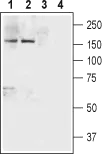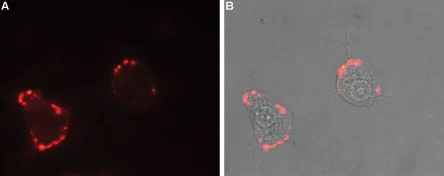
WB analysis of rat brain (lanes 1 and 3) and mouse brain (lanes 2 and 4) lysates using GTX54845 Neurexin 1 antibody preincubated with or without immunogen peptide. Dilution : 1:400
Neurexin 1 antibody
GTX54845
ApplicationsImmunoFluorescence, Western Blot, ImmunoCytoChemistry, ImmunoHistoChemistry, ImmunoHistoChemistry Frozen, Other Application
Product group Antibodies
ReactivityHuman, Mouse, Rat
TargetNrxn1
Overview
- SupplierGeneTex
- Product NameNeurexin 1 antibody
- Delivery Days Customer7
- ApplicationsImmunoFluorescence, Western Blot, ImmunoCytoChemistry, ImmunoHistoChemistry, ImmunoHistoChemistry Frozen, Other Application
- CertificationResearch Use Only
- ClonalityPolyclonal
- Concentration0.8 mg/ml
- ConjugateUnconjugated
- Gene ID60391
- Target nameNrxn1
- Target descriptionneurexin 1
- Target synonyms60S ribosomal protein L10a pseudogene; neurexin I-alpha; neurexin I-beta; neurexin-1; neurexin-1-alpha; neurexin-1-beta; non-processed neurexin I-alpha; Nrxn1b
- HostRabbit
- IsotypeIgG
- Protein IDQ63372
- Protein NameNeurexin-1
- Scientific DescriptionThis gene encodes a single-pass type I membrane protein that belongs to the neurexin family. Neurexins are synaptic transmembrane receptors that bind endogenous ligands that include neuroligins, dystroglycan, and neurexophilins. Neurexin complexes are required for efficient neurotransmission and are involved in synaptogenesis. In vertebrates, alternate promoter usage results in multiple isoform classes, of which the alpha and beta classes are the best characterized. In humans, allelic variants in this gene are associated with Pitt-Hopkins-like syndrome-2, while deletions have been associated with autism and schizophrenia. Mouse knockouts display decreased spontaneous and evoked vesicle release resulting in impaired synaptic transmission. In addition, knockout mice show altered social approach, reduced social investigation, reduced locomotor activity, and in males, increased aggression. [provided by RefSeq, Nov 2016]
- ReactivityHuman, Mouse, Rat
- Storage Instruction-20°C or -80°C,2°C to 8°C
- UNSPSC12352203
References
- NRXN1 depletion in the medial prefrontal cortex induces anxiety-like behaviors and abnormal social phenotypes along with impaired neurite outgrowth in rat.Read more

